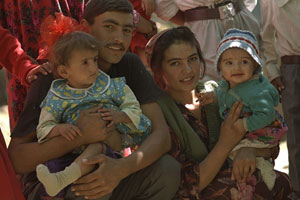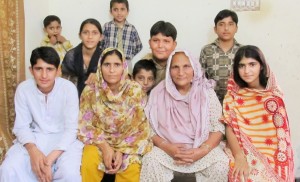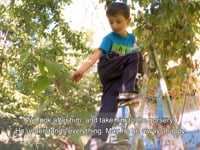2.1 Home life

For most of us, and for most children, home life is comprised of our daily experiences with our families. These family experiences are potent for young children. Families mediate a child’s contact with other environments. Parents, other key caregivers, and the home environment are the most powerful and long-lasting influences in the lives of young children.
Changing family life
Child Trends “monitors the global health of the family by tracking 16 indicators of family structure, family socioeconomics, family processes, and family culture in multiple countries around the world” (2015, p. 3) and provides an annual global report. The Executive Summary of the World Family Map 2015: Mapping family change and child well-being outcomes highlight selected findings regarding family structure, family socioeconomics, family processes, and family culture.
Take the following quiz based on the reading.
To learn more about the global health of families, explore the full World Family Map 2015 report.
The next two UN Women links provide more information on changing family life. The first is an infographic showing various kinds of families and their prevalence in different regions. The second depicts several stories of change from settings that focus on improvements in the rights of women and girls as family life rapidly evolves.
The first link looks at types of households and their distribution by region. Look at your own region. Does the data distribution reflect your personal experience? Do you know people who live in each household type?
The stories of change draw upon women’s changing roles in family life. What are some of the key challenges women have faced?
What are some of the supports or policies that have made a difference in their circumstances?

As the World Family Map report found, most people live in families, but the composition and structure of families vary. In a nuclear family, typically, children live with their mother, father, and siblings. Extended (or joint) families, consist of other kin, including different generations, living together as a family. Family structure impacts the child-rearing environment experienced by children. The roles and responsibilities of family members are influenced by culture, traditions, family needs, and changing economic and social conditions.
In the next video, listen as Dr. Rael Ogwari, lecturer in the Department of Educational Psychology at Moi University in Kenya, describes the benefits of the extended family system in the African context. Then listen as Dr. Alex Awiti, founder and director of the East Africa Institute at the Aga Khan University, Nairobi, explains how the extended family structure is compromised with increased urbanization.
What are the benefits of an extended family structure for caregivers and children?
How does increased urbanization affect the extended family structure, home life, caregivers, and children?
What strategies could be applied to support families and children who are impacted by the move to an urban setting?
Parenting
Urbanization is just one reason why family compositions and roles are changing. Educational or economic opportunities locally or abroad, natural disasters and illness in the home are just some of the other reasons prompting new family configurations, caregiving arrangements, and values. Parenting is no longer the sole responsibility of the mother. Consider the following definitions of parents and parenting:
Parenting can be understood as interactions, behaviours, emotions, knowledge, beliefs, attitudes and practices associated with the provision of nurturing care…The term ‘parenting’ or ‘parent’ is not limited to biological parents, but extends to any guardian or caregiver providing consistent care to the child. Those caregivers include fathers, mothers, siblings, grandparents and other relatives, as well as child care providers who play a significant role in caring for infants and young children” (Unicef, n.d., p.2).
In the definition above, parents refer to any person (or persons) who provides consistent care to the child, regardless of the biological relationship. How does this definition align with a common understanding of who is a parent in your context?
How would you define a “parent” and “parenting”?
Around the world, women generally have more responsibility for the care and raising of children, even if they are working outside the home. Grandparents, aunties, siblings, and others may also play an important role. In some countries, mothers-in-law make many of the decisions as to how a child should be raised including feeding, schooling, and so forth. Many programs and initiatives focus on children and mothers. But what about fathers? What are their roles and expectations in the care and raising of children?
The next reading from the Encyclopedia on Early Childhood Development looks at the roles of fathers in different cultural settings and at different times in history. The article also identifies a number of gaps in research on fathers.
Now read an Early Childhood Matters article about two programs in Uganda and Rwanda that work on changing beliefs around gender to encourage equity within families and more father involvement in caregiving.
What benefits did these two programs find when beliefs around dominant gender roles were challenged and father engagement in the care of their children was encouraged?
Both these programs were quite simple, yet effective. Why does this make them easier to scale?
Are there initiatives in your context that encourage and support fathers’ involvement with childcare?
Parental migration
Sometimes decisions regarding work prompt one or both parents to accept a job far from home. This might mean one or both parents need to relocate to another city or leave the country. In these circumstances, families need to decide if they will stay together or separate. When they decide to separate, their children are left behind in the care of other family members, often grandparents.
The decision to leave their children behind, and the subsequent changes that come with it, can have widespread implications on the well-being of families and children. For the most part, the impact on children is not well documented. However, parental migration affects millions of families in China, Eastern Europe, Latin America, and Southeast Asia in particular.
The next reading from the International Journal for Equity in Health describes a qualitative study on the effects of parental migration on children, parents, and caregivers in China.
What were some of the psychosocial impacts of parental migration on children, parents, and caregivers?
What kind of supports might make a difference for these families?
Given the lack of attention to this issue, what ideas do you have for possible research questions and programming?
In central Asia, in many countries that were formerly part of the Soviet Union, there is extensive labour migration to Russia. In the video below, listen to grandparents from villages in the Gorno-Badakhshan Autonomous Region of eastern Tajikistan discuss raising their grandchildren while the parents are working in Russia. The grandparents affirm the importance of the support provided by community ECD programs.
The next reading is a study by Mazzucato et al. (2014) on the effects of parental migration on children’s well-being in 3 African countries. The second reading is a report by the Center for Child Rights and Corporate Responsibility on the status of the 61 “left-behind” children in China.
Finding child care
For millions of families around the world, finding child care was a challenge and considered a global crisis even before the Covid-19 pandemic. Now, “in the current context of lockdown and school closures, lack of childcare is likely to be one of the worst affected services available to families” (Gromada, Richardson & Rees, 2020, p. 1). The UNICEF Innocenti Research Report provides pre-pandemic data about three categories of child care; family care, non-family care, and no care, and highlights new challenges in the COVID-19 context.
What does the data indicate about child care in the country you live or work? What did you learn about other countries?
What impact has COVID-19 had on child care availability in your country or community?
The report provides a number of recommendations. Which are relevant to your context?
The Overseas Development Institute’s (ODI) 2016 report, describes the lack of care available for young children around the world greatly limiting the lives of women and children, particularly for the poor with limited access to child care supports. Read the executive summary of the report.
Do these research findings resonate regarding the situation for children and families in your context?
Who would you say provides the majority of care for preschool children of parents who work-for-pay where you live?
What is being done in your region to address the needs of childcare for preschool children, both in the public and private sectors? Are there families “left out” for example, with little or no access or can not afford the programs?
As you read the 3 scenarios below from the UNICEF report, Supporting Workers with Family Responsibilities, think about how access to affordable or free quality childcare might help to alleviate some of the considerable stress on these families.
In each scenario, economic insecurity places great stress on the parents. How does this stress influence parenting? How does it impact other members of the family?
What differences might it make for these children and their families if they had access to affordable, quality childcare?
In your context, what local, sub-national, and national solutions exist (or could exist) to help families like the ones in the above scenarios?
For more detailed information, read chapter 3 “Who else is looking after the children”, in Women’s work: Mothers, children and the global child care crisis.
Early Childhood in Focus 5: Supporting Parenting looks at factors that influence parenting and impact children’s well-being, parenting programs, and their effectiveness.
Separation and divorce
Many families experience some form of separation, and divorce is common in many countries. Inevitably this affects home life for children although the effects are not necessarily negative or long term, depending on the circumstances. The Encyclopedia on Early Childhood Development provides the following series of articles and resources that focus on how to minimize the effects of divorce and separation on children.
How prevalent is separation/divorce where you live?
What are some of the ways it can affect young children?
What do the readings tell you about what can parents do to mitigate the stress of separation/divorce on their children?



